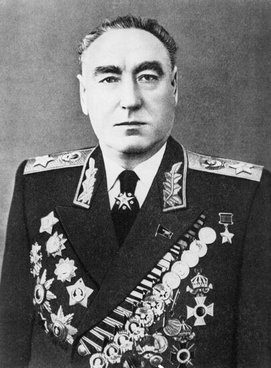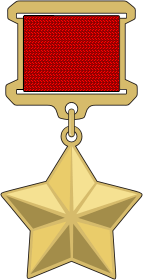Sergey Biryuzov facts for kids
Quick facts for kids
Sergey Semyonovich Biryuzov
|
|
|---|---|
 |
|
| Born | 21 August 1904 Skopin, Russian Empire |
| Died | 19 October 1964 (aged 60) near Belgrade, Yugoslavia |
| Buried | |
| Allegiance | |
| Service/ |
Red Army |
| Years of service | 1922–1964 |
| Rank | |
| Commands held | 37th Army Soviet Air Defence Forces Strategic Missile Troops |
| Battles/wars | World War II Cuban Missile Crisis |
| Awards | Hero of the Soviet Union Order of Lenin (5) People's Hero of Yugoslavia Order of the Red Banner (3) Order of Suvorov Order of Kutuzov (2) Order of Bogdan Khmelnitsky |
Sergey Semyonovich Biryuzov (Russian: Серге́й Семёнович Бирюзо́в; August 21, 1904 – October 19, 1964) was a very important military leader in the Soviet Union. He became a Marshal of the Soviet Union, which is the highest military rank. He also served as the Chief of the General Staff, meaning he was in charge of planning military operations for the entire country.
Contents
Early Life and Military Training
Sergey Biryuzov was born in a town called Skopin in the Russian Empire. His family were working-class people.
He joined the Red Army in September 1922 when he was 18 years old. He went to different military schools to learn how to be a soldier and a leader.
- He studied at infantry and machine gun courses in Rostov-on-Don and Vladikavkaz.
- Later, he went to the VTsIK Combined Military School in Moscow.
After finishing his studies in 1926, he became a platoon commander. A platoon is a small group of soldiers. In the same year, he joined the Communist Party of the Soviet Union. This was important because it was the ruling political party in the Soviet Union.
He continued to study and train, even going to the Military Faculty of the Moscow Zootechnical Institute. This shows he was always learning and improving his skills. He moved up in the army, becoming a company commander and then a battalion commander. A battalion is a larger group of soldiers than a company.
In 1934, he went to the Frunze Military Academy, a very famous military school. After graduating, he became the chief of staff for the 30th Rifle Division. This meant he helped plan and organize everything for that division. By 1939, he was in charge of the 132nd Rifle Division.
World War II: A Brave Commander
Sergey Biryuzov led the 132nd Rifle Division for three years during World War II. This was quite unusual for Soviet generals, as they often changed commands quickly.
His division fought on the Southwestern and Bryansk Fronts. Biryuzov was known for being a very good leader. He often led his soldiers directly into battle. He was wounded five times in the first year of the war, with two of those injuries being very serious. This shows how bravely he fought alongside his troops.
In April 1942, he became the Chief of Staff for the 48th Army. He helped lead this army until November 1942. Then, he became the Chief of Staff for the 2nd Guards Army.
The Battle of Stalingrad
Biryuzov played a key role in the Battle of Stalingrad. This was one of the most important battles of World War II. The 2nd Guards Army helped to defeat the German 6th Army, which had been surrounded. This was a huge victory for the Soviet Union.
Planning Victories
In April 1943, Biryuzov became the Chief of Staff for the Southern Front. He worked closely with the commander, Fyodor Tolbukhin. They were a great team. The Southern Front was later renamed the 4th Ukrainian Front.
In May 1944, he moved to the 3rd Ukrainian Front with Tolbukhin. In October 1944, Biryuzov took command of the 37th Army. He led this army until the end of the war in May 1945.
In these roles, Biryuzov helped plan and carry out major operations. These operations pushed all German forces out of the Ukraine. He then helped plan the liberation of Bulgaria and Yugoslavia from German control.
Cold War Leadership
After World War II, Biryuzov continued to hold important positions.
- He was the Head of the Soviet Military Mission in Bulgaria until May 1946.
- He then became a deputy commander for the Ground Forces, focusing on combat training.
Between 1947 and 1953, he commanded the Primorskiy Military District. This was a large military area. He then became a top deputy commander for the Far Eastern Military District.
In June 1953, Biryuzov was sent to lead the Central Group of Forces. From May 1954, he took on several senior roles in the Soviet Air Defence Forces. These forces protected the Soviet Union from air attacks.
On March 11, 1955, Sergey Biryuzov was given the highest military rank: Marshal of the Soviet Union. From 1955 to 1962, he was the Commander in Chief of the Soviet Air Defence Forces.
After that, he spent almost a year as Commander in Chief of the Strategic Rocket Forces. These forces were in charge of the Soviet Union's most powerful missiles. In March 1963, he became the Chief of the General Staff. This made him the top military planner in the entire Soviet Union.
Tragic Death
On October 19, 1964, Marshal Biryuzov and 32 other people were killed. Their plane, an Ilyushin Il-18, crashed into Mount Avala near Belgrade, Yugoslavia. His ashes are buried in the Kremlin, a very important place in Moscow, Russia.
Awards and Honors
Sergey Biryuzov received many awards for his bravery and leadership.
Soviet Union Awards
- (five times)
- (three times)
- , 1st class
- , 2nd class
- , 1st class
- , 1st class
Foreign Awards
- (Bulgaria)
- , 1st class with swords (Kingdom of Bulgaria)
- (Kingdom of Bulgaria)
- , 1st class (Kingdom of Bulgaria)
- , 1st class with swords (Kingdom of Bulgaria)
- (China, twice)
- , 1st class (North Korea)
- (North Korea)
- (Yugoslavia, given after his death)
- , 1st class (Yugoslavia)
- , 1st Class (Yugoslavia)
Images for kids
See Also
 In Spanish: Serguéi Biriuzov para niños
In Spanish: Serguéi Biriuzov para niños





















